Toyota C-HR: All Comprehensive Review of the Compact Crossover SUV Introduction
As attributed to ‘Coupe High Rider’, it is literally everything it imagined in terms of appeal among the urban dwellers and families. Originally launched back in 2016 as a ploy from Toyota’s wishful thinking to carve into the fast-growing compact SUVs and hybrid cars, the Toyota C-HR indeed has preached the expression of an artistic, affordable, and fuel-efficient vehicle that has been one of the top-selling vehicles by combining practicality with updated designs and technology.
We trace the lineage of evolution from the conceptual phase of the vehicle to the latest and most recent version of the Toyota C-HR. We track themes in design, performance, essential features of a car of such nature, and finally, the positioning within the market. We go into hybrid technology, the driving experience, and safety and where it stands in the product lineup of Toyota.
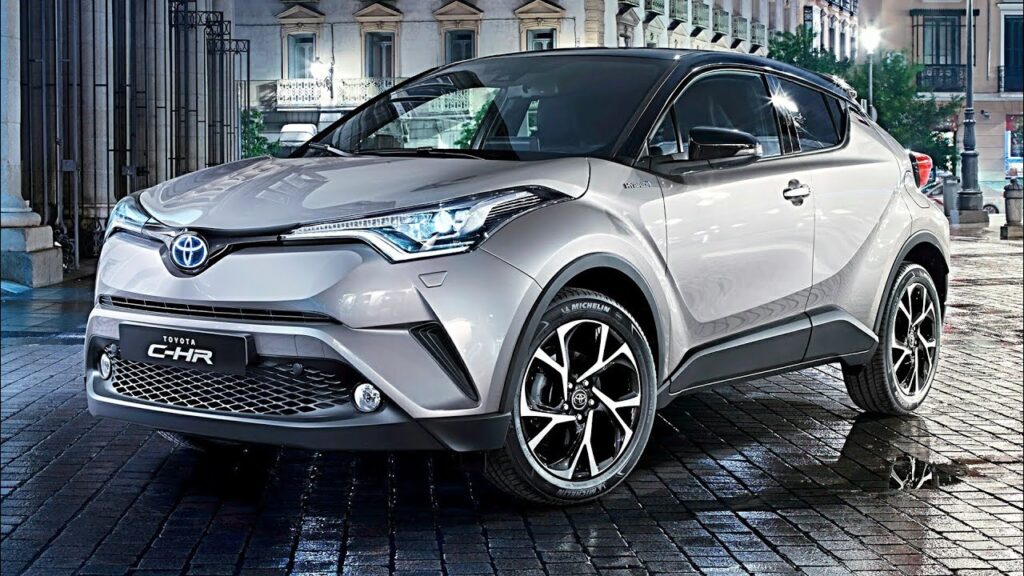
History of the Toyota C-HR
The car had made its first official appearance outside the Toyota Crown design studios at the 2016 Geneva Motor Show. The car was indeed projected to come as a new subcompact SUV to the market, which was initially gaining interest as it seemed to sprout out from its very design and aggressive style. C-HR actually is a successful offspring of fruitful cooperation of European, Japanese, and North American design studios targeted exclusively to Toyota, for something special in the already overcrowded compact crossover niche.
When it came along, the C-HR model was already much basking in much success coming from the giant models like the RAV4 and Highlander, which, incidentally is boxier in design. A category the C-HR would target is of those who would look for a much more youthful, edgy, and lifestyle-oriented car. Thus, in this respect, the design of the C-HR is quite away from the rather conservative looks seen with other Toyota offerings.
One would want to say that it was one of the first models of Toyota , which uses a platform – Toyota New Global Architecture (TNGA) under which such hits of the corporation as Prius and Corolla share with it. At the same time, with this center of gravity lowered, it improves driving grip; in its general tendency, it makes the structure overall more rigid.
Launched under the bonnet of the C-HR, in 2017, it is available as a hybrid and appeals to environmentally sensitive consumers. Hybrids have formed the core of the offer within the C-HR range with brilliant fuel economy and low emission.
Exterior Design: Bold and Trending
Exterior Styling The Toyota C-HR, no doubt, is simply a gorgeous gorgeous automobile. Any demographic will discover this compact crossover dramatically good-looking-from that sleek coupe-like profile down to the bold, angular lines. Design language of the C-HR is hardly similar to many conventional SUVs: for a look and attract a young customer or someone looking for something with a little more panache.
Front Facia
This car can be given a very aggressive and eye-catchy look with very aggressive, large front grills along with angular headlighting features. Headlight LEDs add much to the feelings of a modern car. The frontal bumper gets intakes made highly emphasized, sculpted details, thereby enhancing the image as sporty and high performance.
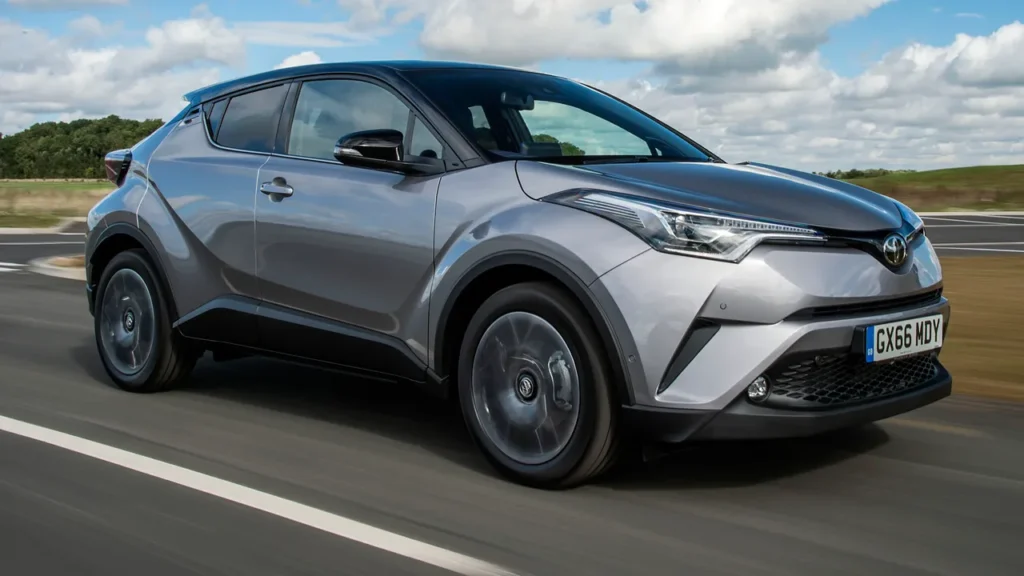
Side Profile
There’s a swooping roofline that could lend the C-HR silhouette on a side a little more coupe feel, even with an energetic pose and huge amounts of athleticism. The Toyota C-HR mounts up big wheels-17- or 18-inch alloys, respectively-but even those smartly angled character lines that stretch along the sides add to that impression of movement even when it stands still. Cute, tasteful rear door handles are again set hidden out of the way near the rear window, completing that C-HR clean and minimalist design.
Rear
The rear view throws off a rear spoiler outlining the boldness of Toyota in putting this car sporty-looking while sporting sharp angular designs within its taillights and sculpted bumpers featuring an integrated exhaust outlet. In general, it was very boldly built to be coherent with the aggressive front as well as the profile both sides of the vehicle.
Furthermore, bi-tone paints, such as the contrasting color add a little feel to the C-HR. Bi-tone paint is characterized by a different color for its roof that contrasts with the body color. It can be featured in one or more of the trim options that play a remarkable dramatic part in the car.
Interior: Comfort Meets Technology
The interior of the Toyota C-HR is completely modern, and with comfort and dashing technology, they really rattled the cage. Of course, because this is a compact crossover, the cabin does have that premium feel with good quality materials and attention to detail. When it comes to design, this will be just how bold it was outside but this time, more on functionality and practicality.
Space and Sitting
Its seating capacity may reach five. But the front has been designed more for comfort and support rather than being too sporty or high-performance-oriented. Higher trims have leather upholstery to really give that premium feel. The rear seats are not roomy as compared to others full-size SUVs, but they should adequately hold two adults or children. So, the C-HR is perfect for small families or those who commute solo or with one person most of the times.
Noise levels have dropped with the use of sound-damping materials and, in its zeal to fine-tune the driving experience, Toyota holds itself up on. It becomes ideal for brief town runs and road touring because it collapses the rear seats flat to extend cargo space as it also makes it capable of carrying greater loads of cargo.
Technology and Infotainment
It is quite user-friendly, and in some trims, it fits the car with a 7- or an 8-inch display screen. It also flaunts Apple CarPlay and Android Auto compatibility that make integrating smartphones with the car extremely easy. Otherwise, the C-HR also comes with Bluetooth connectivity and USB ports, with more advanced audio systems in higher trims.
But one of the major talking points over the Toyota C-HR has to be the Toyota Safety Sense suite of advanced driver-assistance technologies, including a pre-collision warning system, lane departure warning system, lane tracing assist system, adaptive cruise control system, and road sign assist. The supremely feature-rich suite of standard safety features also brings huge value to every single model – a great boon of peace of mind for drivers as well as passengers alike.
The Toyota C-HR would well be a balanced exactly if one goes for performance, comfort and also the efficiency in terms of fuel. Models also come with gasoline power and hybrid, hence providing the option to the consumers on environmental or preference basis.
Engines and Performance
Gasoline Engine
END
A neutrally tuned 2.0-litre four-banger under the skin sits and is estimated to make 144 horsepower and 139 lb-ft of torque. The unit mates to a continually variable transmission-CVT, and that should serve to maximize fuel economy while still providing silky-smooth drive. The C-HR offers standard front-wheel drive, but this model is devoid of all-wheel drive.
That would be good enough to do all that mundane work with effortless step-off acceleration and sharp response. Tuned efficiency comes along with the CVT transmission of the C-HR, mixed with well-tuned C-HR suspension, to assure comfort.
Besides, the edition has another special version of hybrid. However the car in the regard of this review is equipped with its highest power 122 horsepower from its 1.8-l four-cylinder engine and electric motor. This car has an electronically controlled CVT, which indeed technically completely erases any shifting of gear shifts by proper regulation of the power flow between the gas engine and the electric motor.
The winner of this tournament would be the Toyota C-HR Hybrid. It will burn a proven combined fuel economy as high as 50-55 miles per gallon across markets, which really makes it all the more very ideal for those environmentally conscious drivers. And indeed, the electric motor may well move the vehicle at very low speeds without needing to start the gasoline engine; thus, the hybrid system could indeed offer buttery acceleration perfectly able to drive .
There is nothing in the hybrid system which cares for high-performance drive, but just enough in muscles for both city and highway combined and dividend in reducing emissions and better fuel efficiency. Drive Dynamics
The Toyota C-HR feels secure yet agile on the road to drive. Compact dimensions make it an easy fit into most of the megaspace strictures, as well as onto crowded city streets. Both virtues-relative low center of gravity and extremely sensitive steering-do much to make for an extremely good handling and cornering ability. City driving had always been the lithe and spry one; suspension could eliminate bumps and quite harsh surfaces on a fairly good road to make for a very smooth ride.
It is the only hybrid example-that has a smooth, fun noise-free ride and smooth drive appeal. Comfort addicts will also enjoy it since they will also have bright environment footprint. Not even a performance SUV; the C-HR really acquires pretty well all those common issues most owners have: comfort, efficiency, and ease of handling.
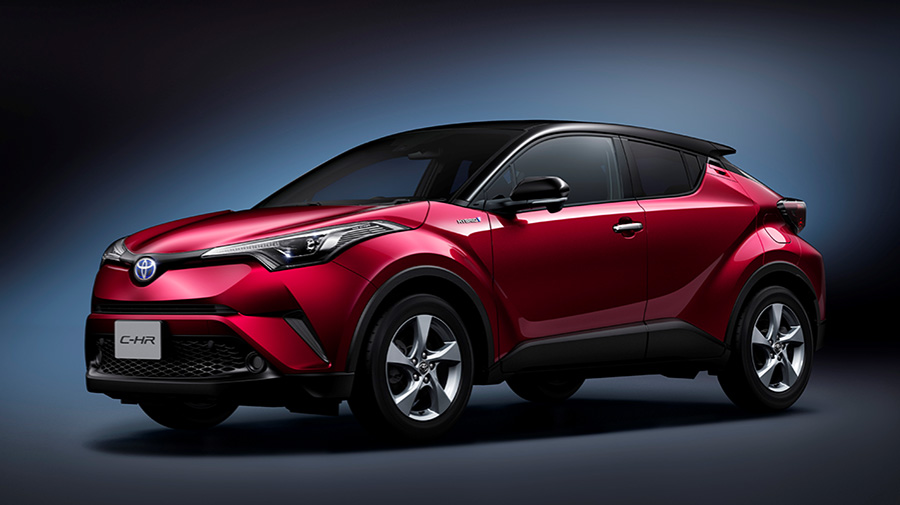
Safety Features and Ratings
Hence, with advanced aware safety, Toyota does all its possible works and thus fitted all its models, and C-HR is not an exception. All the gadgets are produced with the standard of Toyota Safety Sense 2.5, or TSS 2.5 for short. Advanced Features: The PreCollision System comprises view of Pedestrian Detection. It is well-equipped with a camera and collaborating radar for the purpose of collision detection. If it likes, it may break.
Lane Tracing Assist controls the lateral deviation of the vehicle from its lane through small steering correction inputs.
Adaptive Cruise Control:
This would keep the minimum possible distance from the headway vehicle, meanwhile controlling its speed
Road Sign Assistant:
This might detect some of the road signs, and what it detects would be displayed on the dashboard so that the driver would be alerted.
But due to the failure of security of some bodies, such as National Highway Traffic Safety Administration and Insurance Institute for Highway Safety, because of some incidents of crash tests; Toyota C-HR has undergone tremendous changes. Added to this is the feature of a safety suite along with the wonderful properties of protection in case of a crash, making C-HR deliver comfortable and confident driving and riding.
Toyota C-HR in Global Market
The car captured the world markets, including North America, Europe, and Asia at a time when the world experienced it. It is mainly sold as a hybrid except in other markets where it is sold as gasoline. Toyota C-HR has enjoyed immense welcome in Europe due to its compact SUV status that is on trend and much more in terms of fuel efficiency.
It will face the biggest challenge in the continent: a tide of subcompact crossovers, the segment that the Honda HR-V, Mazda CX-3, and the Hyundai Kona are an answer to.
Toyota C-HR Aerodynamics: Form and Function in Perfect Harmony
The Toyota C-HR is among the compact crossover SUVs that have recently received a lot of attention because of their sharp looks, generous fit of advanced tech, and fantastic fuel economy. However, what is missing in that bag is what keeps such a car aerodynamic-the unseen factor that works to the advantage of the said vehicle’s performance. In current car design, Aero is even more important concerning the improvement of fuel efficiency for cars, better handling of the vehicle, and noise reduction. Regarding this, in Toyota C-HR, finer detail attention to aerodynamics helped smoothen the performance of the car while giving it a look that is very striking and dynamic.
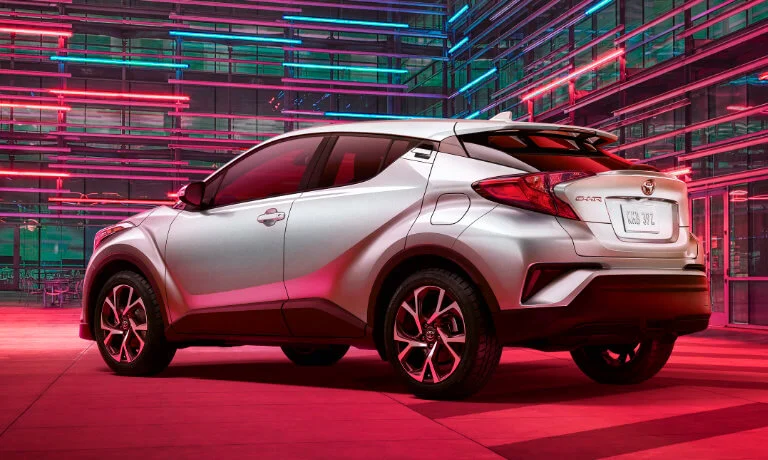
What Is Aerodynamics and Why Does It Matter?
Aerodynamics is the way air interacts with a vehicle in motion. A well-designed aerodynamics will have fewer drags, reducing the noise of the wind and optimizing fuel efficiency so that the car cuts through air with minimal resistance. It means that less energy as well as, by extension, fuel will be consumed and needed to be used and maintained at the steady speed-a very important consideration in an increasingly sensitive, ecologically aware automobile world.
For example, Toyota C-HR is designed for the use of urban and suburban territories. Besides being energy-efficient, aerodynamics of the body allow stabilizing the vehicle and reducing noise on the road, and hence, a comfortable ride, by which drivers of this class care most of all.
Aerodynamics in the Body of the Toyota C-HR
And the Toyota C-HR design speaks of the company’s commitment to the marrying of form and functionality. Its body-styled look seems at first glance as though it’s only about being styled, but closer inspection tells a story of how much aerodynamics went into the making of this vehicle. Engineers at Toyota have obsessed over every curve of the C-HR so that air flow around and through the vehicle is optimized.
- Shy, Steeply Raked Roof: There is something uniquely beautiful about the Toyota C-HR; the dynamic roof line raked with a steep rake accentuates aerodynamics with a lower coefficient of drag while helping the flow over the rooftop-that implies it offers less resistance, which subsequently implies better fuel efficiency and low strain on the engine.
- Rear Spoiler and Roof Edge: The rear spoiler is installed for the Toyota C-HR. It greatly works to regulate air flow together with the vehicle’s rear section. Through this, it eliminates the developed high-speed turbulent air that has been created at the rear section; thus increasing stability all around it and drag reduction. Careful design of the rear roof edge helps to regulate the exit from the roofline of air in a manner that will not lead to disturbing turbulence and drag.
- Angular Sharp Linings: The Toyota C-HR has angular sharp linings along its side of the car. It does serve the aggressive, macho front of the vehicle but most importantly, helps with those airflow moves for most gain. It breaks air into detailed parts further to increase its flow while reducing drag and making it an advanced aerodynamics in the vehicle.
- Front Fascia and Grille: The new C-HR boasts a sporty moulded front fascia with a meshed grille. Other than the aesthetic value that this adds to the new car, it is also meant to help manage airflow around the vehicle. Optimizing the flow path around the air which passes around the front of the car would likely minimize drag and stabilize the car at a higher speed, thanks to the engineers at Toyota.
- Wheels Design: Aerodynamics is applied when designing the wheels for the Toyota C-HR. There are wheels that are already designed in such a way that the air flow around the body of the car is achieved more efficiently, thereby avoiding its drag and thus fuel efficiency is improved.
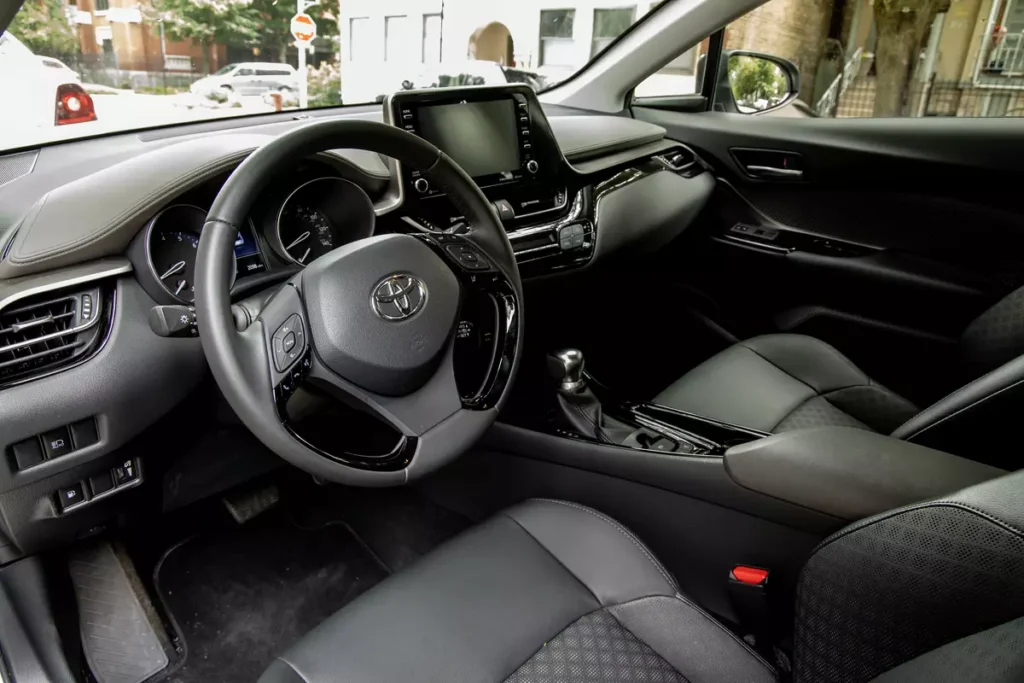
Aerodynamics Performance Benefit of Toyota C-HR
While the aerodynamic features of the Toyota C-HR contribute towards the makings of something sporty and bolder, they do indeed translate to real performance on the road. The most obvious of course is fuel efficiency. Careful engineering has allowed the C-HR to cut through air in a relatively more simple drag-reducing motion, maximising fuel economy. Very elementary to the drivers, it requires them to accomplish some kind of balance between the performance and efficiency, something that is now a big concern in urban settings due to the consumption of fuel becoming very critical.
A higher efficiency of the C-HR was through its aerodynamics. This is because reduced drag combined with a controlled flow of air around the vehicle provides for much more stable ride, especially on highways or greater speeds. This therefore contributes to greater driving confidence when cornering or even when negotiating crosswinds.
An excellent example of blending style and performances is to be expected from the aerodynamic designs of Toyota C-HR. The beauty of combining sleek sculpted lines with functional design features, such as a rear spoiler, sloping roofline, and optimized wheel design comes off perfectly well in the creation that Toyota came up with-one that looks good yet is very efficient in performance. It would still remain one of the prime concerns of automotive technology to make a motor car aerodynamically perfect, and thoughtful execution of aerodynamic features can lend that extra punch of performance, besides looking smashing, as is the case with Toyota C-HR.
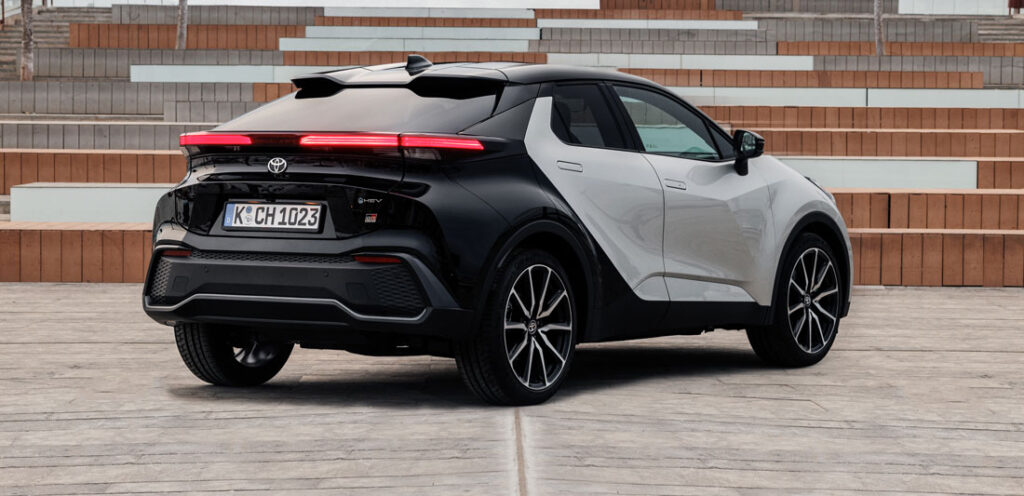
Conclusion OF Toyota C-HR
Though this car stands several inches shorter in most measurements than most of its direct competitors, the styling of this car, combined with hybrid offerings, is surely extremely appealing because today’s buyer also looks for what makes him or her apart from their peers in an ever-saturating marketplace. So therefore, all those features and technologies the car offers can be reached with great value. Best compact crossover to date, stylish: it’s only the Toyota C-HR-innovative designs meet cutting-edge technology to offer rich and efficient performance.
A whole range of hybrid powertrain options, advanced safety features, and perhaps most importantly, there’s certainly aggressive styling to go around, but also a reason to attract its urban dwellers, small families, and even a pinch of eco-conscious drivers: this compact crossover car. Nevertheless, the car far from being the biggest lags behind the leader of its class.
However, objectively it outpaces its classmates according to the parameters: efficiency, comfort and easiness of driving. The final goal of the Toyota C-HR is to be there each day as an absolute necessity to accomplish the driving experience inside the city since it serves as a small and stylish complete car to be used by those people who require an excellent little vehicle. There’s always the promise of keeping it safe, especially more so due to an excellent driving experience behind Toyota’s known reputation for durability and longevity, whether that is its gasoline or hybrid.